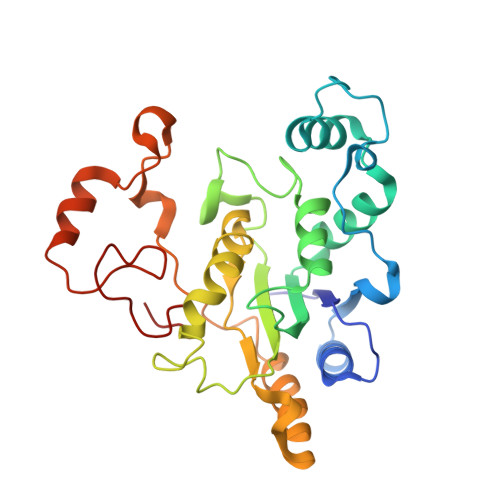Characterization of a mechanism-based inhibitor of NAD(P)H:quinone oxidoreductase 1 by biochemical, X-ray crystallographic, and mass spectrometric approaches.
Winski, S.L., Faig, M., Bianchet, M.A., Siegel, D., Swann, E., Fung, K., Duncan, M.W., Moody, C.J., Amzel, L.M., Ross, D.(2001) Biochemistry 40: 15135-15142
- PubMed: 11735396
- DOI: https://doi.org/10.1021/bi011324i
- Primary Citation of Related Structures:
1KBO, 1KBQ - PubMed Abstract:
We report the characterization of 5-methoxy-1,2-dimethyl-3-[(4-nitrophenoxy)methyl]indole-4,7-dione (ES936) as a mechanism-based inhibitor of NQO1. Inactivation of NQO1 by ES936 was time- and concentration-dependent and required the presence of a pyridine nucleotide cofactor consistent with a need for metabolic activation. That ES936 was an efficient inhibitor was demonstrated in these studies by the low partition ratio (1.40 +/- 0.03). The orientation of ES936 in the active site of NQO1 was examined by X-ray crystallography and found to be opposite to that observed for other indolequinones acting as substrates. ES936 was oriented in such a manner that, after enzymatic reduction and loss of a nitrophenol leaving group, a reactive iminium species was located in close proximity to nucleophilic His 162 and Tyr 127 and Tyr 129 residues in the active site. To determine if ES936 was covalently modifying NQO1, ES936-treated protein was analyzed by electrospray ionization liquid chromatography/mass spectrometry (ESI-LC/MS). The control NQO1 protein had a mass of 30864 +/- 6 Da (n = 20, theoretical, 30868.6 Da) which increased by 217 Da after ES936 treatment (31081 +/- 7 Da, n = 20) in the presence of NADH. The shift in mass was consistent with adduction of NQO1 by the reactive iminium derived from ES936 (M + 218 Da). Chymotryptic digestion of the protein followed by LC/MS analysis located a tetrapeptide spanning amino acids 126-129 which was adducted with the reactive iminium species derived from ES936. LC/MS/MS analysis of the peptide fragment confirmed adduction of either Tyr 127 or Tyr 129 residues. This work demonstrates that ES936 is a potent mechanism-based inhibitor of NQO1 and may be a useful tool in defining the role of NQO1 in cellular systems and in vivo.
- Department of Pharmaceutical Sciences, School of Pharmacy, University of Colorado Health Sciences Center, Denver, Colorado 80262, USA.
Organizational Affiliation:


















